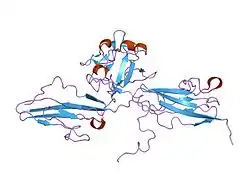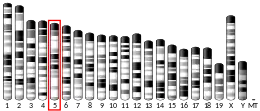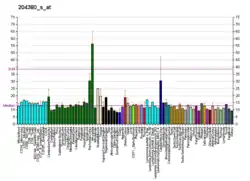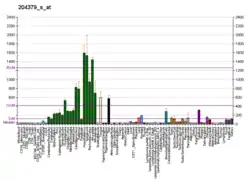گیرنده ۳ فاکتور رشد فیبروبلاست
گیرندهٔ ۳ فاکتور رشد فیبروبلاست (انگلیسی: Fibroblast growth factor receptor 3) یا CD333، یک پروتئین است که در انسان توسط ژن «FGFR3» کُدگذاری میشود[4] که بر روی بازوی کوتاه کروموزوم ۴ واقع شده و در غضروف، مغز، روده و کلیهها بیان میشود.[5]
جهش در این ژن سبب تأخیر یا اشکال در رشد غضروفها و استخوانیشدن آنها شده[5] و ممکن است منجر به اختلال در جوشخوردن جمجمه[6] و بروز چنین نوع از دیسپلازیهای استخوانی گردد. علاوه بر این، اختلالات این گیرندهٔ مهم با آکندروپلازی، کراتوز سبورئیک[7] و سرطان مثانه[8] در ارتباط است.
منابع
- GRCm38: Ensembl release 89: ENSMUSG00000054252 - Ensembl, May 2017
- "Human PubMed Reference:". National Center for Biotechnology Information, U.S. National Library of Medicine.
- "Mouse PubMed Reference:". National Center for Biotechnology Information, U.S. National Library of Medicine.
- Keegan K, Johnson DE, Williams LT, Hayman MJ (February 1991). "Isolation of an additional member of the fibroblast growth factor receptor family, FGFR-3". Proceedings of the National Academy of Sciences of the United States of America. 88 (4): 1095–9. doi:10.1073/pnas.88.4.1095. PMC 50963. PMID 1847508.
- Wang, Y., Liu, Z., Liu, Z., Zhao, H., Zhou, X., Cui, Y., & Han, J. (2013). Advances in research on and diagnosis and treatment of achondroplasia in China. Intractable & Rare Diseases Research, 2(2), 45-50.
- Mulliken JB, Steinberger D, Kunze S, Müller U (November 1999). "Molecular diagnosis of bilateral coronal synostosis". Plastic and Reconstructive Surgery. 104 (6): 1603–15. doi:10.1097/00006534-199911000-00001. PMID 10541159.
- Hafner C, Hartmann A, Vogt T (July 2007). "FGFR3 mutations in epidermal nevi and seborrheic keratoses: lessons from urothelium and skin". The Journal of Investigative Dermatology. 127 (7): 1572–3. doi:10.1038/sj.jid.5700772. PMID 17568799.
- Lamy A, Gobet F, Laurent M, Blanchard F, Varin C, Moulin C, Andreou A, Frebourg T, Pfister C (December 2006). "Molecular profiling of bladder tumors based on the detection of FGFR3 and TP53 mutations". The Journal of Urology. 176 (6 Pt 1): 2686–9. doi:10.1016/j.juro.2006.07.132. PMID 17085196.
- مشارکتکنندگان ویکیپدیا. «Fibroblast growth factor receptor 3». در دانشنامهٔ ویکیپدیای انگلیسی، بازبینیشده در ۱۸ ژوئیه ۲۰۱۸.
بیشتر بخوانید
- Schweitzer DN, Graham JM, Lachman RS, Jabs EW, Okajima K, Przylepa KA, Shanske A, Chen K, Neidich JA, Wilcox WR (January 2001). "Subtle radiographic findings of achondroplasia in patients with Crouzon syndrome with acanthosis nigricans due to an Ala391Glu substitution in FGFR3". American Journal of Medical Genetics. 98 (1): 75–91. doi:10.1002/1096-8628(20010101)98:1<75::AID-AJMG1010>3.0.CO;2-6. PMID 11426459.
- Horton WA, Lunstrum GP (December 2002). "Fibroblast growth factor receptor 3 mutations in achondroplasia and related forms of dwarfism". Reviews in Endocrine & Metabolic Disorders. 3 (4): 381–5. PMID 12424440.
- Bonaventure J, Silve C (November 2005). "[Hereditary skeletal dysplasias and FGFR3 and PTHR1 signaling pathways]". Médecine Sciences. 21 (11): 954–61. doi:10.1051/medsci/20052111954. PMID 16274647.
- Hernández S, Toll A, Baselga E, Ribé A, Azua-Romeo J, Pujol RM, Real FX (July 2007). "Fibroblast growth factor receptor 3 mutations in epidermal nevi and associated low grade bladder tumors". The Journal of Investigative Dermatology. 127 (7): 1664–6. doi:10.1038/sj.jid.5700705. PMID 17255960.
- Olsen SK, Ibrahimi OA, Raucci A, Zhang F, Eliseenkova AV, Yayon A, Basilico C, Linhardt RJ, Schlessinger J, Mohammadi M (January 2004). "Insights into the molecular basis for fibroblast growth factor receptor autoinhibition and ligand-binding promiscuity". Proceedings of the National Academy of Sciences of the United States of America. 101 (4): 935–40. doi:10.1073/pnas.0307287101. PMC 327120. PMID 14732692.
پیوند به بیرون
- FGFR3 protein, human در سرعنوانهای موضوعی پزشکی (MeSH) در کتابخانهٔ ملی پزشکی ایالات متحدهٔ آمریکا
This article is issued from Wikipedia. The text is licensed under Creative Commons - Attribution - Sharealike. Additional terms may apply for the media files.




